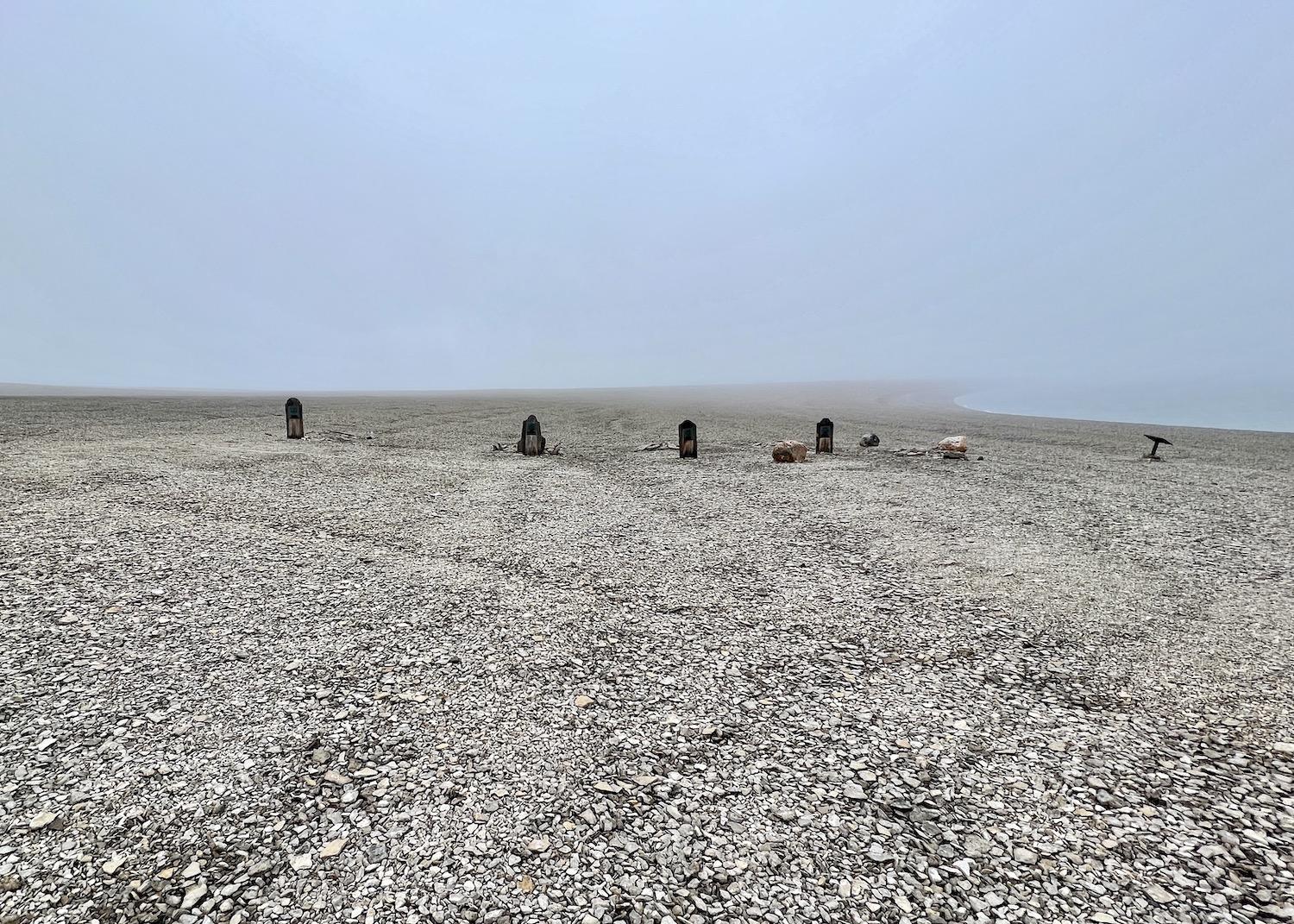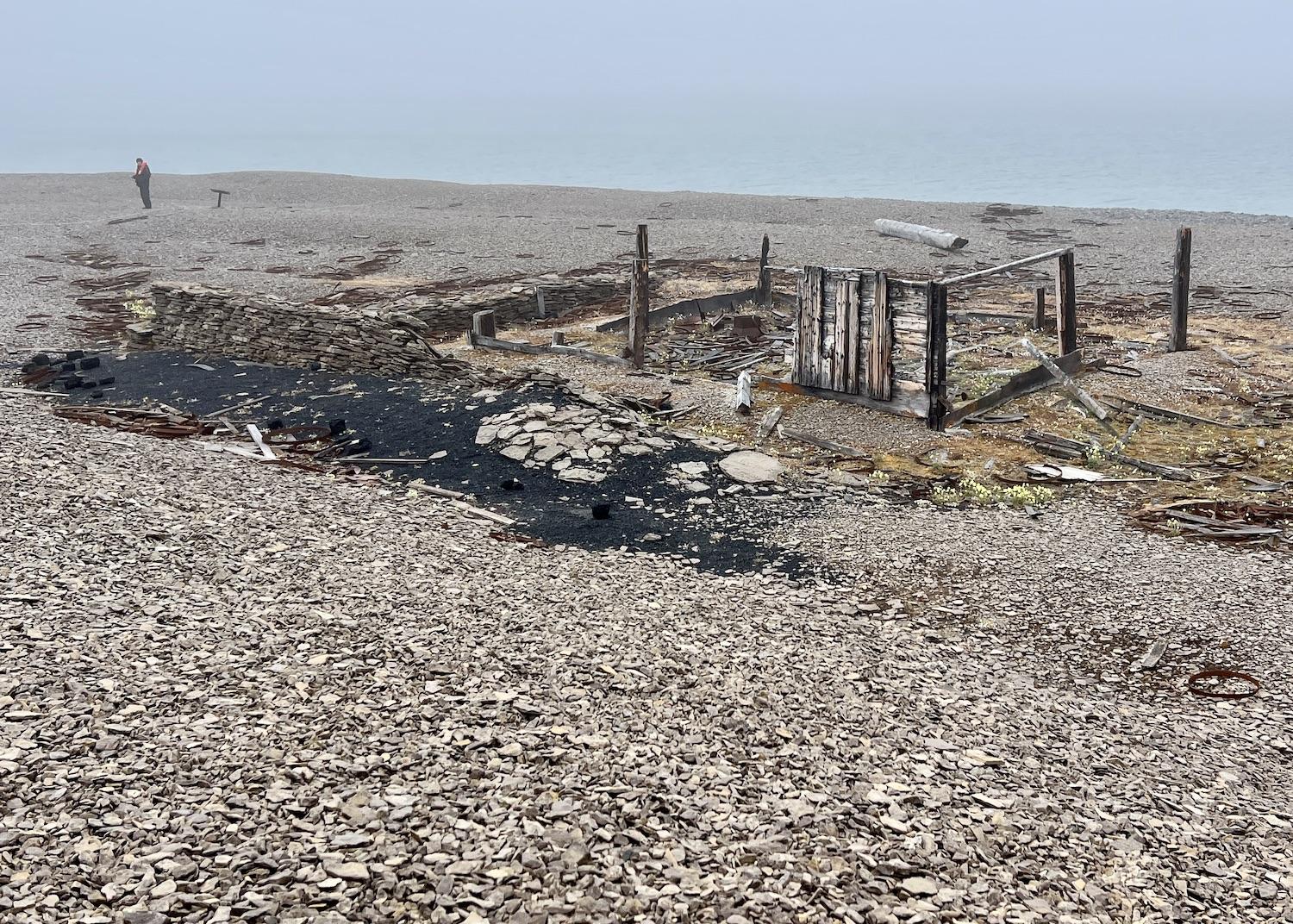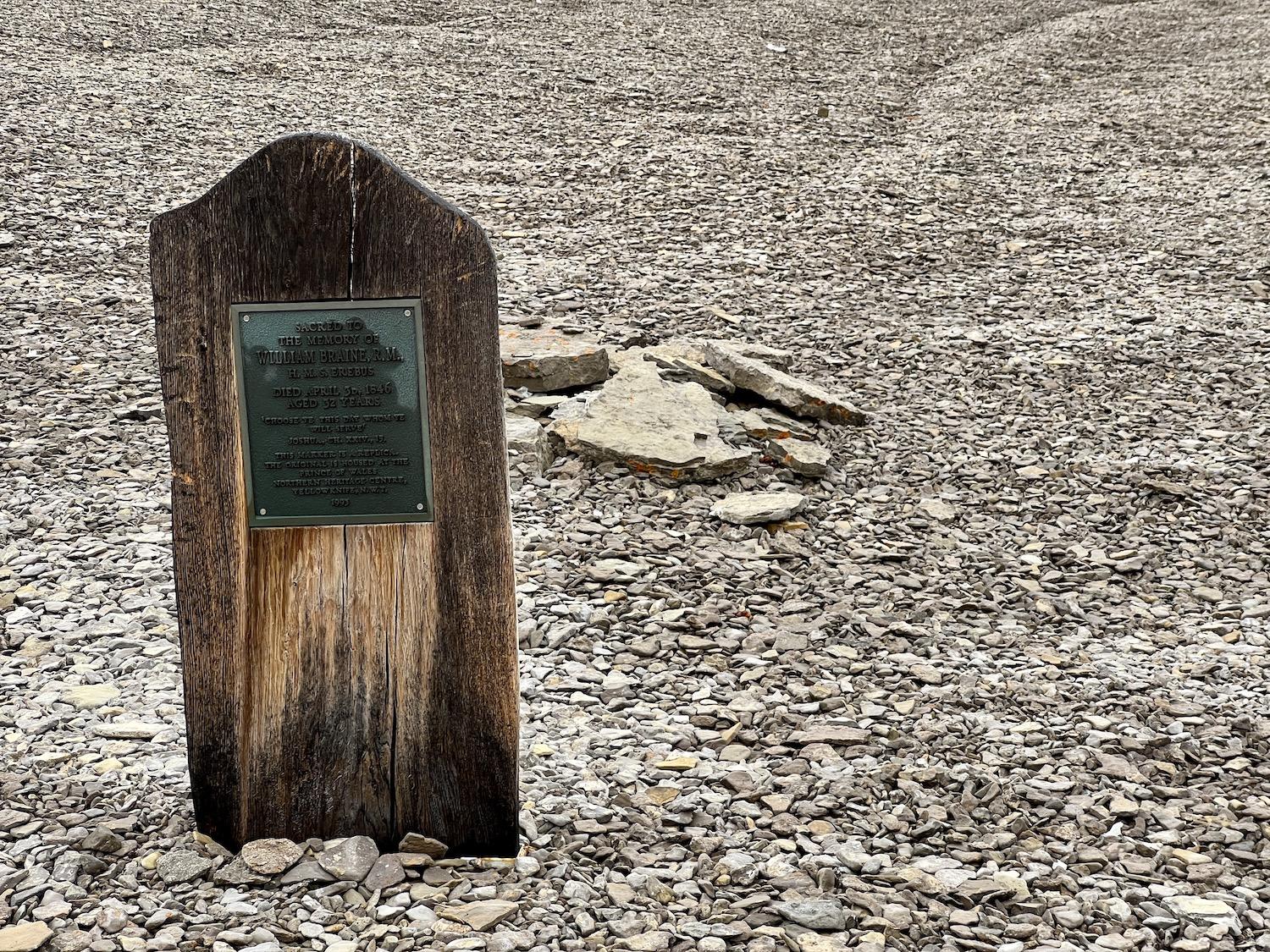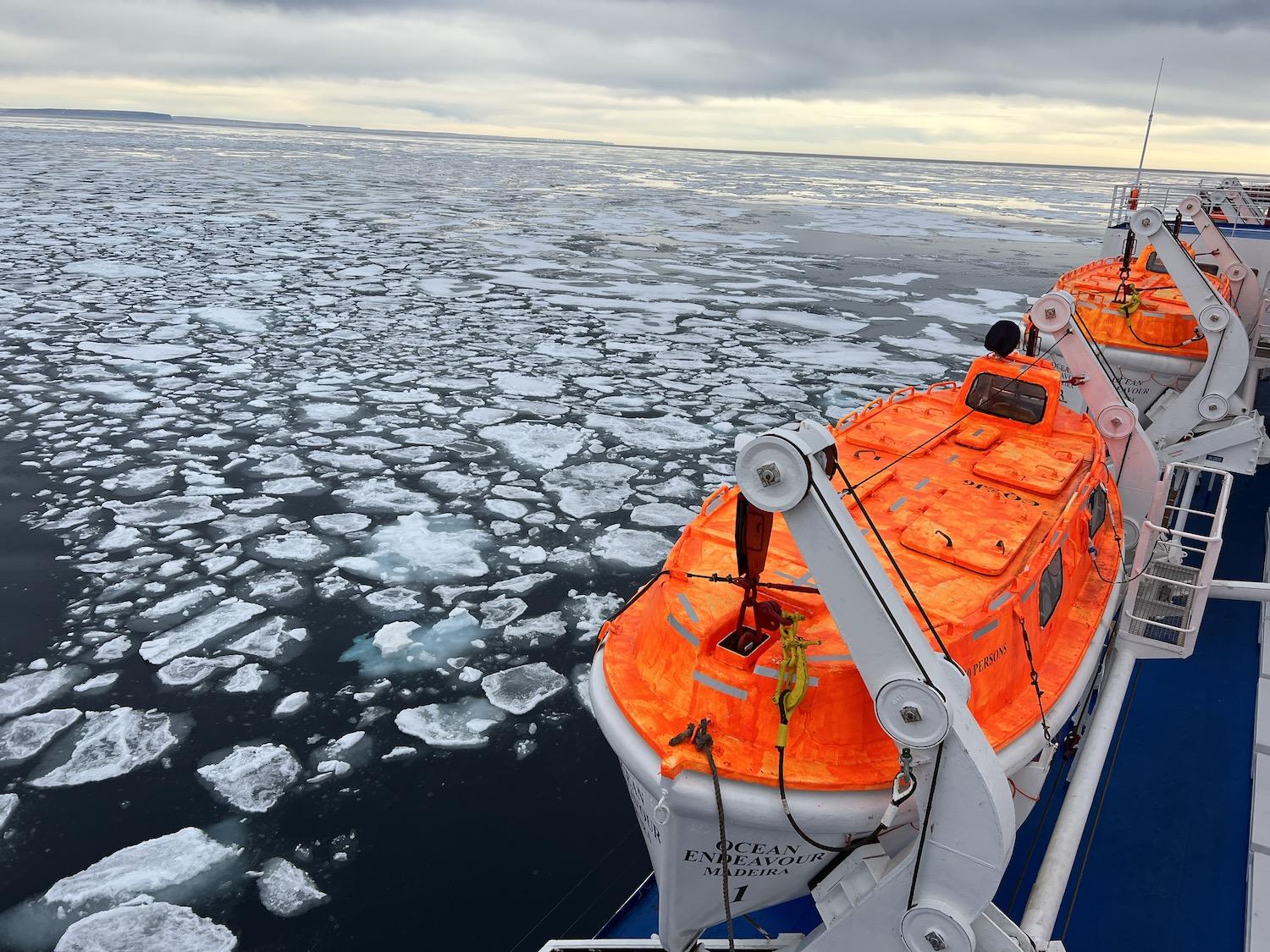
Beechey Island, Nunavut is home to graves from Sir John Franklin's doomed Northwest Passage expedition/Jennifer Bain
It was foggy with a high probability of polar bears the morning we anchored off desolate Beechey Island and held our breath waiting to hear whether it was safe to go to shore. The tension mounted over breakfast for those who had sailed from Greenland to Nunavut with the dream of seeing the place where Sir John Franklin’s doomed Northwest Passage expedition spent the winter of 1845-1846, and where three of his men are buried.
We had already arrived in Canada four days late due to weather, changed course because the hamlet of Mittimatalik was iced in, pushed valiantly through sea ice in our ice-strengthened expedition ship the Ocean Endeavour, cleared customs just off Qausuittuq, and then backtracked through the night to Beechey.
At 6:55 a.m., program director Grace Cordsen finally made an announcement: “We are on schedule to start disembarkation in about five minutes time.”

One of Adventure Canada's bear monitors keeps an eye out during a foggy landing at Beechey Island, Nunavut/Jennifer Bain
The Zodiac transfer from the ship to the island would take less than 10 minutes with lots of chop and spray, so we would need wet weather gear. But there was one catch. Instead of enjoying a mile-long walk between the graves and the ruins of a supply depot made in vain for Franklin’s crew, we would be shuttled by boat because the visibility was too low for armed bear guards to set a perimeter and keep watch over us.
Now the countdown was really on for the 133 passengers on Adventure Canada’s High Arctic Explorer route. We had been divided into six groups for shore landings and the order rotated each day. For Beechey, my group was slated to go fifth — and not until 9 a.m. Anything could happen in the next two hours.
“We have seen polar bears there in the past, and if there’s a bear on site we have to yield to that bear,” expedition leader John Blyth had warned. “So just hold that thought that if there’s a bear standing at those graves, I can’t just zoom up there with a Zodiac and scare it away so you can go to Beechey Island. Or, if it’s extra-extra foggy — as we’ve also dealt with on this trip — we’ll just have to wait.”

A view of the famed Beechey Island, Nunavut taken from a Zodiac on a foggy and forlorn day in August/Jennifer Bain
Beechey Island Sites National Historic Site may be a popular stop for expedition cruises that sail the Canadian Arctic every summer, but visits are never guaranteed.
The Franklin story began in May 1845 when he left England in command of the Royal Navy’s most ambitious Northwest Passage expedition with 128 men on the HMS Erebus and the HMS Terror to find the rumoured shortcut to the Far East. The ships were last seen in July by whalers in Lancaster Sound within the Inuit homeland in what’s now Nunavut.
The explorers battled ice, scurvy, tuberculosis and lead poisoning from improperly tinned food. Some resorted to survival cannibalism before they all died over the next few years. The graves of Petty Officer John Torrington, Royal Marine Private William Braine and Able Seaman John Hartnell were found at Beechey, where Franklin’s men had overwintered on their ships.

Northumberland House was a supply depot set up in case the Franklin expedition returned to Beechey Island/Jennifer Bain
The weather held out that foggy 41F August morning when I anxiously waited to get to Beechey. But the expedition team decided we would all see Northumberland House before the all-important gravesite and so we still had to cross our fingers and hope nothing would bring a halt to the outings while they were in progress.
With a Parks Canada permit in hand, we would divide into guided groups of 25 and get to visit each spot for 30 precious minutes. We couldn’t touch, move, pick up or turn over anything, as anything could be an artifact. Ropes would be laid on the ground to keep us 10 feet away from the main archaeological sites.
Beechey — a peninsula connected to larger Devon Island — is mostly flat with a weather-worn limestone beach and small hills. When I jubilantly stepped on shore, I had just a few minutes to wander over to a few yellow Arctic Poppies and Purple Saxifrage (Nunavut's official flower) before being directed to the ruins of Northumberland House to begin the reverse-chronological visit.

Archaeologist Kaylee Baxter provides interpretation at the ruins of Northumberland House on Beechey Island/Jennifer Bain
“You’re actually starting later in time,” acknowledged archaeologist Kaylee Baxter. Built on the shore here seven years after the Franklin expeditioners were first stranded, this house was “very much a Hail Mary idea” in case the men somehow survived and returned.
The supply depot had stone walls and was made of wood from a wrecked whaling vessel. Now it’s in shambles, partly because of 170-plus years of visitors, but also because polar bears likely tore the place apart searching for food. “One pretty critical line of evidence for that is because there was a completely untouched cask of rum left in the house,” Baxter explained. “Of course, with any human explorer, that would be the first thing to go.”
For several decades, search parties passed through Beechey looking for Franklin and his men while continuing to hunt for the Northwest Passage. Outside Northumberland House’s crumbled walls are the remnants of a coal pile reportedly used by Norwegian explorer Roald Amundsen during his Arctic expeditions.

Next to the Northumberland House ruins are other memorials to Arctic explorers, including a cross made of tin cans/Jennifer Bain
“This was definitely the hub for many a polar explorer,” Baxter observed before leading us up a slope to overlook the ruins. We passed several memorial cairns, some related to the Franklin saga and a few of the “we were here” ilk that are technically vandalism but have become part of the protected archaeology.
It was my second visit to Beechey, but admittedly I didn't fully appreciate the Franklin story the first time when I was able to roam more freely and check out the island's geology, plant life and wildlife. It was Baxter’s first visit. The fact there were early Inuit and Paleo-Inuit camp sites on a more protected part of the island with better camping and hunting was more in line with the type of work she does, but we couldn’t venture that far because of fog.
“So for me, this is definitely the more historical side of archaeology because we have the story,” Baxter mused. “We have lots of written accounts of what happened and, of course, we have the physical remains to corroborate that. I’m used to working in time periods where we have no written accounts and it’s just through the physical remains that we’re putting the story together. It kind of feels like I could read about what we’re doing today almost completely, fully. We have names and we have precise dates, so it’s neat.”
With that, she switched to “train conductor” mode and sent us back to the Zodiacs for part two of our archaeology outing.

A few flowers were spotted on Beechey Island, including Purple Saxifrage, the official flower of Nunavut/Jennifer Bain
We know that Franklin’s crew wintered on Beechey but became icebound off King William Island the next year and eventually abandoned the ships. Franklin died June 11, 1847 according to the famous “Victory Point Note” that was left behind. The men kept moving on foot and slowly died of starvation.
A flurry of search parties used Beechey as a base. Parks Canada now protects five separate sites on land and in the nearby sea. Archaeological resources range from cairns and graves to the wooden building ruins and the wreck of HMS Breadalbane, which became trapped in an ice floe and was crushed in 1853 while searching for Franklin’s lost expedition.
The fog was rolling in and out when I finally arrived at the graves, the most tangible place that Franklin buffs can visit. The three graves are spread out in a row just steps from the ocean, beside a fourth one for Thomas Morgan from the HMS Investigator, who died in 1854 during one of the dozens of expeditions to find out what happened to Franklin’s group.

For our Beechey Island visit, Adventure Canada laid down rope to keep us about 10 feet from the Franklin graves/Jennifer Bain
As with Northumberland House, the Adventure Canada team had laid down a rope to ensure we kept a respectful distance from the graves. Historian and Royal Canadian Geographical Society ambassador Joseph Frey stood by to bring the sombre site to life.
He explained that Franklin’s tight-knit crew overwintered on the ships but built a storehouse, blacksmith’s forge and smaller sheds on land. In 1981, the bodies of Torrington, Braine and Hartnell were exhumed for autopsies that finally revealed they died of tuberculosis but also had lead poisoning. The men had been lovingly buried, wrapped in different fabrics and laid to rest on wood chip pillows.

The original headstones for the there Franklin graves have been removed for safekeeping and replaced with wooden replicas/Jennifer Bain
The original markers were stone with words chiselled into them. Those have been moved to the Canadian Museum of History in Gatineau, Quebec for safekeeping and replaced with replicas made of wood with bronze plaques. The bodies, too, have been returned to this final resting site.
Franklin’s body still hasn’t been found, but the Erebus was recovered to great fanfare in 2014 and the Terror two years after that. Underwater archaeologists are racing to recover what they can during limited dive seasons each year near Gjoa Haven at what's now protected as the Wrecks of HMS Erebus and HMS Terror National Historic Site.
The Franklin expedition didn’t find the Northwest Passage, but it did spark search parties that discovered three passages and mapped half of the Canadian Arctic. Nearly two centuries later, people from around the world remain fascinated by the tragic story that still hasn't been fully told.

To get to Beechey Island from Greenland, the Ocean Endeavour had to pass through this sea ice on the way to Qausuittuq (Resolute Bay) to clear Canadian customs/Jennifer Bain
Beechey Island was still shrouded in fog when we left, chilled and grateful for the brevity of our shore visit and the absence of polar bears. Unlike the unimaginable challenges that Franklin’s crew endured, our discomfort was fleeting and we were whisked back to our ship for a barbecue lunch (indoors) to celebrate our last full day aboard.
That afternoon, Inuit cultural educator Franco Buscemi shared photos celebrating the wild beauty of Nunavut, and the vibrant, colorful images stood in stark contrast to the bleakness of Beechey. The expedition team’s Alex Preston, who has sailed on 14 ships in the Arctic and Antarctica, spoke about what life is like for the Ocean Endeavour’s multinational crew who spend most of the year working a tough job at sea far from home.
Blyth, our expedition leader, expressed relief at being able to deliver Beechey, knowing how important it was to so many people. Things had been touch and go since the start of our 12-day, 2,036-mile voyage, when ice charts predicted challenges in Canada. In the end, a decision to dawdle in Greenland to give the ice a chance to break up was the right call.
We toasted Captain Hervé Parage, who rose to bid us farewell and remind us who is in charge in the Arctic. “We are seeking to share with you what we love,” he said. “We are doing what nature allows us.”

Lifeboats aboard the Ocean Endeavour as she sails through sea ice in Lancaster Sound, Nunavut/Jennifer Bain

 Support Essential Coverage of Essential Places
Support Essential Coverage of Essential Places



